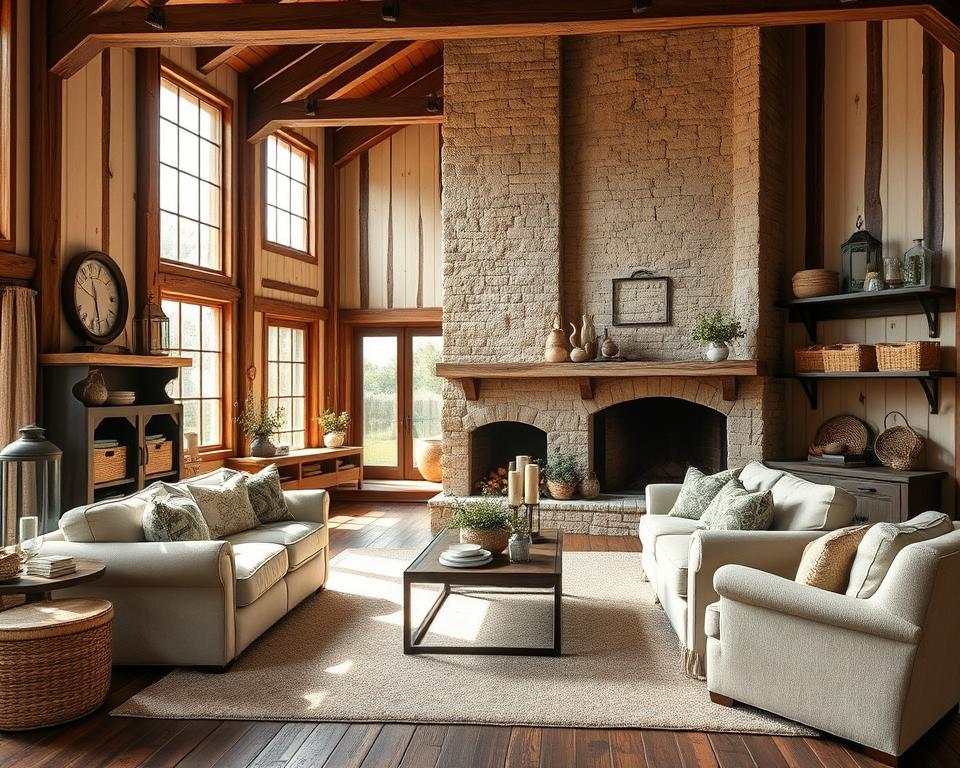Farmhouse style has become a staple in interior design, evoking feelings of warmth, comfort, and nostalgia. With its rustic charm and emphasis on simplicity, it draws inspiration from rural homes, often incorporating natural materials and a cozy, lived-in aesthetic. One of the key elements that define farmhouse interiors is the use of reclaimed wood, a material that not only enhances the authenticity of the design but also tells a story of sustainability and craftsmanship.
Reclaimed wood is wood that has been salvaged from old buildings, barns, and other structures, giving it a unique history and character. It has gained immense popularity due to its environmental benefits, offering a sustainable alternative to newly sourced timber. By repurposing this wood, designers and homeowners contribute to reducing deforestation and waste while embracing a more eco-friendly approach to design.
In the context of farmhouse style, reclaimed wood serves as a perfect match, offering a natural, rustic look that complements the organic, welcoming atmosphere the style is known for. Its imperfections, such as knots, faded colors, and weathered textures, add depth and authenticity to farmhouse interiors, creating spaces that feel both timeless and grounded in nature.
In this article, we will explore how reclaimed wood serves as an essential component of the farmhouse aesthetic, highlighting its unique qualities and the numerous benefits it brings to home design. Whether you’re renovating your space or building a new one, reclaimed wood can be the perfect material to help you achieve the warm, inviting farmhouse look you desire.
In the context of farmhouse style, reclaimed wood serves as a perfect match, offering a natural, rustic look that complements the organic, welcoming atmosphere the style is known for. Its imperfections, such as knots, faded colors, and weathered textures, add depth and authenticity to farmhouse interiors, creating spaces that feel both timeless and grounded in nature.
The appeal of reclaimed wood in farmhouse design extends beyond its aesthetic. This material has a strong connection to the past, carrying with it the story of the structures it once helped build. Whether it’s salvaged from old barns, factories, or warehouses, the wood brings a sense of history and craftsmanship to any space. These reclaimed materials often retain the marks of their previous use—scratches, dents, and weathered finishes—that give each piece a unique, storied quality. This connection to the past is what makes reclaimed wood such a prized material in the farmhouse style, as it helps create spaces that are not just beautiful but meaningful.
In this article, we will explore how reclaimed wood serves as an essential component of the farmhouse aesthetic, highlighting its unique qualities and the numerous benefits it brings to home design. Whether you’re renovating your space or building a new one, reclaimed wood can be the perfect material to help you achieve the warm, inviting farmhouse look you desire. Through its natural beauty, environmental benefits, and ability to tell a story, reclaimed wood elevates farmhouse interiors to new heights, making it a timeless choice for homeowners seeking a sustainable and cozy living environment.
What is Reclaimed Wood?
Reclaimed wood is wood that has been salvaged from old buildings, barns, factories, or other structures that are no longer in use. Instead of cutting down new trees for timber, reclaimed wood is repurposed from previously used materials, giving it a new life in modern design. The process of reclaiming wood involves removing the boards or beams from old structures, cleaning, and restoring them for reuse. Often, this wood comes with a history — it may have been part of a barn in the countryside or the flooring in an old factory, each piece carrying a unique story and character. This makes reclaimed wood an environmentally friendly and sustainable choice for interior design.
Characteristics of Reclaimed Wood and its Relation to Farmhouse Style
The natural characteristics of reclaimed wood align perfectly with the farmhouse style, known for its rustic, organic, and timeless appeal. The imperfections found in reclaimed wood — such as knots, rough textures, color variations, and weathered surfaces — are what give it its charm and authenticity. These elements contribute to the warm, lived-in feel that defines farmhouse interiors. The rich patina of reclaimed wood also creates a sense of history and connection to the past, which resonates with the farmhouse ethos that celebrates simplicity and craftsmanship. Additionally, reclaimed wood often has a rich, varied texture, adding depth to any space, which is a key feature in creating the cozy, inviting atmosphere that farmhouse interiors are known for.
Benefits of Using Reclaimed Wood in Farmhouse Design
There are several benefits to using reclaimed wood in farmhouse design, spanning ecological, aesthetic, and economic advantages:
- Ecological Benefits: Reclaimed wood is a sustainable material that reduces the need for new timber and minimizes deforestation. By using reclaimed wood, homeowners and designers help preserve forests and reduce waste, as these materials would otherwise end up in landfills. Reclaimed wood also requires fewer resources to process compared to new wood, making it an eco-friendly option for conscious consumers.
- Aesthetic Benefits: Reclaimed wood brings a distinct charm to farmhouse interiors. Its weathered appearance, rich textures, and aged tones create a unique, timeless beauty. Each piece of reclaimed wood has its own character, which adds depth and personality to your home, making every piece of furniture, flooring, or wall feature a one-of-a-kind element.
- Economic Benefits: While reclaimed wood can sometimes be more expensive than new wood, it offers long-term savings. By repurposing existing materials, homeowners avoid the costs associated with deforestation and the energy-intensive processes of manufacturing new wood. Additionally, reclaimed wood often requires less maintenance, as it is already weathered and durable.
How to Incorporate Reclaimed Wood into Different Areas of Farmhouse Design
Reclaimed wood is a versatile material that can be used in various areas of the home, creating a cohesive and rustic farmhouse look:
- Furniture: Reclaimed wood can be used to create stunning pieces of furniture, from dining tables and chairs to bookshelves and sideboards. The unique grains and textures of reclaimed wood ensure that each piece is visually striking and adds a rustic charm to any room.
- Flooring: Reclaimed wood flooring is a popular choice for farmhouse homes. It adds warmth and character, with each plank telling its own story. Whether you opt for wide boards with visible knots or a more refined look, reclaimed wood floors are durable and timeless.
- Walls: Reclaimed wood can be used as wall paneling or feature walls. Its natural patina and texture bring a sense of warmth and history to spaces like living rooms, kitchens, and bedrooms. Whether it’s used as shiplap or in a more traditional style, reclaimed wood walls create an inviting atmosphere.
- Décor: Smaller accents such as reclaimed wood shelves, picture frames, and lighting fixtures can complement the larger design elements in the room. These pieces tie together the rustic farmhouse look and add functional beauty to the space.
Techniques for Treating and Preserving Reclaimed Wood
To ensure reclaimed wood remains durable and functional over time, proper treatment and preservation are essential. Here are a few techniques:
- Cleaning and Sanding: Reclaimed wood often requires cleaning to remove dirt, nails, and other debris. Sanding can help smooth out rough surfaces and highlight the wood’s natural grain, enhancing its beauty.
- Sealing and Finishing: Applying a protective finish or sealant can help preserve the wood’s appearance and protect it from damage. A matte finish is often preferred in farmhouse designs for its natural look, but a polyurethane finish can provide extra durability for high-traffic areas.
- Preventing Moisture Damage: Reclaimed wood should be treated to resist moisture, as it may have absorbed moisture during its previous life. Using proper sealants and ensuring the wood is dry before installation can prevent warping or swelling.
Mixing Reclaimed Wood with Other Materials in Farmhouse Design
One of the beauties of reclaimed wood is how well it pairs with other materials, creating a dynamic and balanced aesthetic. In farmhouse design, reclaimed wood is often combined with:
- Metal: Combining wood with metal elements, such as steel or wrought iron, adds an industrial touch to farmhouse interiors. Metal fixtures and hardware like exposed lightbulbs, metal shelves, or steel-framed tables complement the warmth and rustic nature of reclaimed wood.
- Glass: Glass elements, such as windows, light fixtures, or tables with reclaimed wood bases, provide contrast while maintaining the open, airy feel that is characteristic of farmhouse interiors.
- Stone: Stone and reclaimed wood pair naturally, offering a blend of organic textures. Stone fireplaces, walls, or countertops can be accented with reclaimed wood furniture or beams, creating a rustic yet refined look.
Farmhouse Design Trends with Reclaimed Wood
Reclaimed wood continues to be a central element in farmhouse design, but its use evolves with emerging trends:
- Minimalistic Farmhouse: A more streamlined, modern farmhouse style that uses reclaimed wood in its raw, unpolished form. The focus is on clean lines and simple shapes, with reclaimed wood used as a statement feature, such as on accent walls or in custom furniture pieces.
- Mixed Wood Finishes: Today’s farmhouse designs are moving away from the traditional all-wood approach and embracing a mix of reclaimed wood finishes. For example, lighter woods can be paired with darker finishes, creating a more eclectic and layered design.
- Sustainability-Focused Designs: With increasing awareness of environmental impact, more homeowners are incorporating reclaimed wood into designs that emphasize sustainability, such as eco-friendly homes and green building projects.
Reclaimed wood is a timeless material that continues to shape and define farmhouse interiors. Its natural beauty, sustainability, and versatility make it an ideal choice for those looking to create a warm, rustic home with a personal, eco-conscious touch.
Reclaimed Wood in Farmhouse Style: A Sustainable and Cozy Choice
Reclaimed wood is more than just a design trend—it’s a sustainable, eco-friendly material that adds character and warmth to any farmhouse-inspired home. The unique history embedded in each piece of reclaimed wood not only brings a sense of nostalgia and authenticity to your living space, but also contributes to environmental conservation by reducing waste and minimizing the need for new timber.
By incorporating reclaimed wood into various aspects of farmhouse design, from furniture and flooring to wall treatments and décor, homeowners can achieve a timeless, rustic look that is both functional and aesthetically pleasing. The natural imperfections, rich textures, and weathered finishes of reclaimed wood perfectly complement the relaxed, inviting atmosphere that defines the farmhouse style.
Beyond its beauty and charm, reclaimed wood offers numerous practical benefits, including durability, sustainability, and cost-effectiveness. By opting for reclaimed materials, you’re making a conscious choice to support sustainable design practices while also creating a home that reflects your values and love for craftsmanship.
In conclusion, reclaimed wood is the perfect material for anyone looking to embrace the farmhouse style. It combines environmental responsibility with aesthetic appeal, making it an ideal choice for creating a cozy, timeless space that will last for years to come. Whether you’re updating your existing home or building a new one, incorporating reclaimed wood will ensure that your space feels warm, welcoming, and connected to nature.
Reclaimed wood also offers an opportunity to connect with the past while moving forward into a more sustainable future. Each piece of wood carries a unique story, whether it’s from an old barn, factory, or even a historical building. This connection to history allows you to bring a piece of the past into your home, giving your space a deeper sense of meaning and purpose. The rich, weathered textures and colors are the result of years of use, which adds character and a sense of timelessness to modern spaces. It’s not just about creating a stylish design—it’s about honoring craftsmanship and giving new life to materials that would otherwise be discarded.
Additionally, incorporating reclaimed wood into your home promotes sustainability in a way that new wood simply can’t match. By choosing reclaimed materials, you’re not only avoiding the environmental impact of deforestation but also reducing the waste associated with demolition and renovation projects. It’s a proactive choice that supports green building practices and encourages a more mindful approach to design. Whether you’re using reclaimed wood for large structural features or small accent pieces, it’s a step towards a more sustainable, environmentally-conscious lifestyle.
Another advantage of reclaimed wood is its ability to create a personalized and unique space. Unlike mass-produced materials, no two pieces of reclaimed wood are exactly the same. This means that your furniture, floors, or walls will have a one-of-a-kind look that can’t be replicated. The natural variations in color, grain, and texture add depth and interest to any space, ensuring that your home is full of personality and warmth. It’s a design choice that reflects individuality and authenticity, helping you create a home that is truly yours.
Incorporating reclaimed wood into your farmhouse design not only enhances your home’s aesthetic but also brings numerous benefits that will stand the test of time. It allows you to craft a space that is cozy, sustainable, and full of character while supporting environmentally responsible practices. Whether used as a focal point in your décor or as subtle accents throughout your home, reclaimed wood will always have a place in farmhouse design. It’s a material that brings both beauty and purpose, helping you build a home that’s warm, inviting, and connected to nature.

Rachel Branson is the creator of The Ponds Farmhouse, a blog dedicated to farmhouse décor and DIY projects. With a passion for helping readers create beautiful and unique homes that reflect their personal style, Rachel offers a variety of content, including simple and budget-friendly decorating ideas, DIY and craft projects, thrifting and vintage finds, and entertaining tips.
Throughout her life, Rachel has been an avid DIYer, always seeking budget-friendly ways to achieve high-end, boutique looks. She is fortunate to have the support of her husband, Brad, who assists with the heavy lifting and provides a voice of reason when new ideas arise. Their projects and decorating ideas have been featured in publications such as Farmhouse Style Magazine, American Farmhouse Magazine, and Real Simple.
Through The Ponds Farmhouse, Rachel shares her expertise and passion for farmhouse décor, inspiring readers to create homes they truly love.



